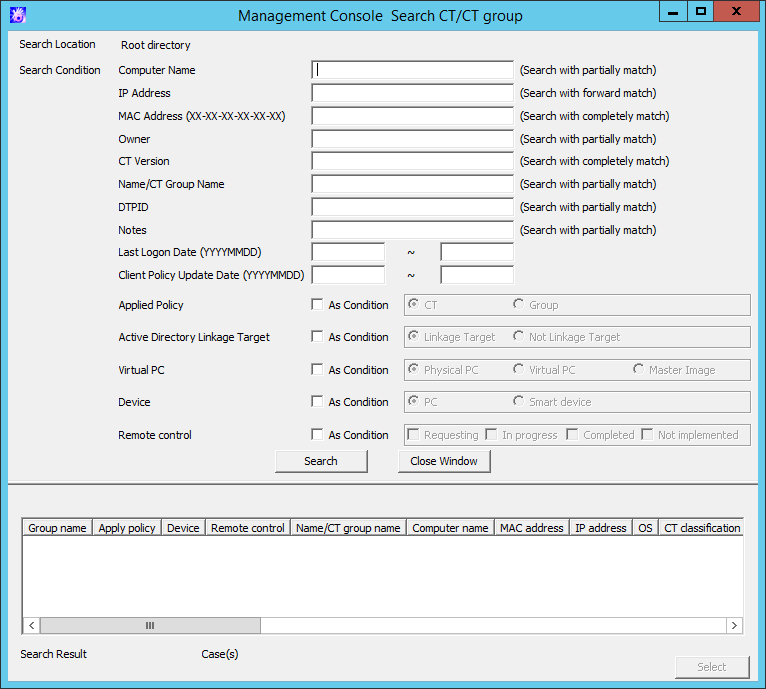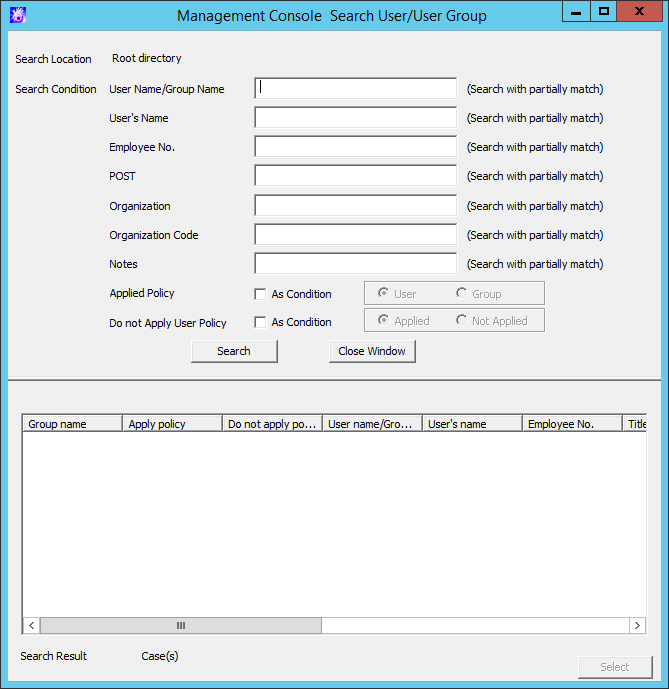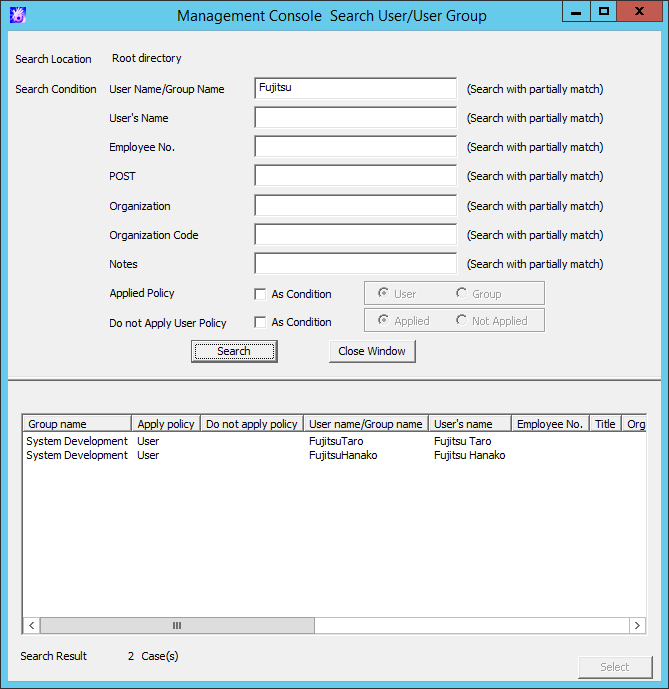Search CT Information
Follow the procedure below to search the CT group and CT displayed in the Management Console.
When the "Deleted CT" group is displayed in the CT group tree of the Management Console, the client (CT) and smart device (agent) to which the "Deleted CT" group belongs will also be searched.
The client (CT) and smart device (agent) of the "Deleted CT" group will be displayed as "Deleted CT" in Group Name of the area for displaying search result.
Start Management Console.
Select the Root directory or "CT Group" to be searched from the CT group tree.
Select Search CT/CT Group from the File menu (or right-click and select Search CT/CT group from the displayed pop-up menu).
The Management Console Search CT/CT group window is displayed.

Enter the following information as the search condition.
The search is the "AND search" that includes multiple conditions.
Search CT group:
Specify Name/CT Group Name and Notes only. In addition, the As condition check box of Applied policy should not be selected.
Search client (CT) and smart device (agent):
Specify the items of search condition.
Item Name | Description | |
|---|---|---|
Computer Name | Search according to the computer name or smart device (agent) model name of the client (CT). Results that partially match with the input conditions will be displayed. | |
IP Address | Search according to the IP address of the client (CT) or smart device (agent). The result of which the front part matches with the input conditions will be displayed. For a dual stack network, search also for the IP address not displayed in the IP Address column in the CT list. If an IPv6 address is specified Specifying "0123:12" will include "123:12:", "123:12X.", and "123:12XX." in the result ("X" denotes a halfwidth numeric character).
For IPv4 addresses, specify up to 45 halfwidth numeric characters and periods. For IPv6 addresses, specify up to 45 halfwidth hexadecimal characters and colons. | |
MAC Address | Search according to the MAC address of the client (CT) or smart device (agent). The result that completely matches with the input conditions will be displayed. Example: 02-E0-32-33-A3-C0 | |
Owner | Search according to the owner set in the OS of the client (CT). Results that partially match with the input conditions will be displayed. | |
CT Version | Search according to the version of the client (CT) or smart device (agent) of the Systemwalker Desktop Keeper installed. Results that completely match with the input conditions will be displayed. Example: 2.1.0.1 | |
Name/CT Group Name | Search according to the name of the CT group, client (CT), or smart device (agent). Results that partially match with the input conditions will be displayed. | |
DTPID | This is displayed when the client (CT) of Systemwalker Desktop Keeper and the client (CT) of Systemwalker Desktop Patrol are installed on the same PC. Enter "userId+pcName" of the client (CT) of Systemwalker Desktop Patrol. (the plus sign must be halfwidth) | |
Notes | Search according to the notes entered when updating the client (CT) or smart device (agent) policy. Results that partially match with the input conditions will be displayed. | |
Last Logon Date | The client (CT) and smart device (agent) communicate with the Master Management Server or Management Server at startup. Search according to the date when this communication is enabled Example: 20130701 | |
Client Policy Update Date | Search according to the last date when the client (CT) or smart device (agent) obtained policy from the Master Management Server or Management. Example: 20130922 | |
Applied | As Condition | When this check box is selected, the policy being applied to the client (CT) and smart device (agent) will be included in the search condition. |
CT | The search target is the client (CT) and smart device (agent) to which the CT policy is applied. | |
Group | The search target is the client (CT) and smart device (agent) to which the CT group policy is applied. | |
Active Directory Linkage Target | As Condition | When this check box is selected, whether it is the client (CT) that imports information from Active Directory will be included in the search condition. |
Linkage Target | The search target is the client (CT) that imports information from Active Directory. | |
Not Linkage Target | The search target is the client (CT) that does not import information from Active Directory. | |
Virtual PC | As Condition | When this check box is selected, the environment with client (CT) installed will be included in the search condition. |
Physical PC | This refers to the client (CT) installed in a physical PC. | |
Virtual PC | This refers to the client (CT) installed in a virtual PC. | |
Master Image | This refers to the client (CT) installed in the master image of a virtual PC. | |
Device | As Condition | Adds to the search condition PCs in which client (CT) is installed or smart devices in which smart device (agent) is installed. |
PC | Adds to the search condition PCs in which client (CT) is installed. | |
Smart device | Adds to the search condition smart devices in which smart device (agent) is installed. | |
Remote control | As Condition | Adds to the search condition devices in which the remote control status is one of the selected values. |
Requesting | Adds to the search condition client (CT) and smart device (agent) that requested remote control. | |
In progress | Adds to the search condition client (CT) and smart device (agent) on which remote control is in progress. | |
Completed | Adds to the search condition client (CT) and smart device (agent) on which remote control has been completed. | |
Not implemented | Adds to the search condition client (CT) and smart device (agent) on which remote control is not implemented. | |
Search | The search will be started and the results will be displayed. | |
Close Window | The entered search condition will be saved. | |
Click the Search button.
The search results are displayed.
The displayed items are the ones selected from the Setting of CT List Display Column window. For the Setting of CT List Display Column, refer to "When modifying the displayed items and sequence".
When double-clicking on the client (CT), smart device (agent) or CT group that has been found, the Management Console window will be displayed, and the corresponding CT or CT group will be in selected state. The Search CT/CT group window will not be closed and will be displayed in minimized status.
Click the Close Window button.
The entered search condition is saved.
The saved search condition will be displayed at the next time when the Search CT/CT group window is started. However, the search condition that is currently input will not be saved if the window is closed by clicking the x button at the top right of the Search CT/CT group window.
Search User Information
Search of user and user group can be executed in the Management Console.
Follow the procedure below to search:
Start Management Console.
Select User Policy Settings from the User Settings menu.
The User Policy Settings window is displayed.
Select the Root directory or User Group to be searched from the user group tree.
Select Search User/User Group from the File menu (or right-click and select Search User/User Group from the displayed pop-up menu).
The Management Console Search User/User Group window is displayed.

Enter the following information as the search condition.
The search is the "AND search" that includes multiple conditions.
Search user group:
Specify User Name/Group Name and Notes only. In addition, the Applied Policy and Do not Applied User Policy check boxes should not be selected.
Search user:
Specify the items of search condition.
Item Name | Description | |
|---|---|---|
User Name/Group Name | Search according to user name and user group name. Results that partially match with the input conditions will be displayed. | |
User's Name | Search according to the name of user that users the user name. Results that partially match with the input conditions will be displayed. | |
Employee No. | Search according to the Employee No. of the user that uses the user name. Results that partially match with the input conditions will be displayed. | |
POST | Search according to the title of the user that uses the user name. Results that partially match with the input conditions will be displayed. | |
Organization | Search according to the organization to which the user that uses the user name belongs. Results that partially match with the input conditions will be displayed. | |
Organization Code | Search according to the organization code to which the user that uses the user name belongs. Results that partially match with the input conditions will be displayed. | |
Notes | Search according to the remark information of the user that uses the user name. Results that partially match with the input conditions will be displayed. Up to 128 single-byte and double-byte characters can be entered. | |
Applied | As Condition | When this check box is selected, the policy that is applied to user will be included in the search condition. |
User | The search target is the user to which the user policy is applied. | |
Group | The search target is the user to which the user group policy is applied. | |
Do not Apply User Policy | As Condition | When this check box is selected, whether the user policy is applied will be included in the search condition. |
Applied | The search target is the user to which the user policy is applied. | |
Not Applied | The search target is the user to which the user policy is not applied. | |
Click the Search button.
The search results are displayed.

When double-clicking on the user or user group that has been found, the Management Console Search User/User Group window will be displayed, and the correspondent user or user group will be in selected state. The Management Console Search User/User Group window will not be closed and will be displayed in minimized status.
Click the Close Window button.
The input search condition is saved.
The saved search condition will be displayed at the next time when the Management Console Search User/User Group window is started. However, the search condition that is currently input will not be saved if the window is closed by clicking the x button at the top right of the Management Console Search User/User Group window.